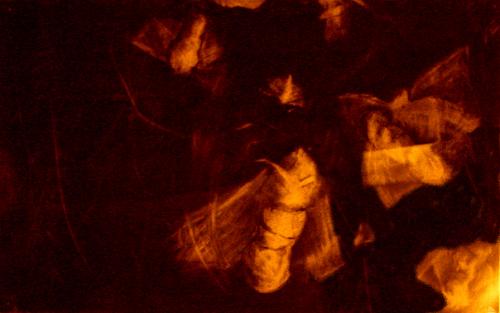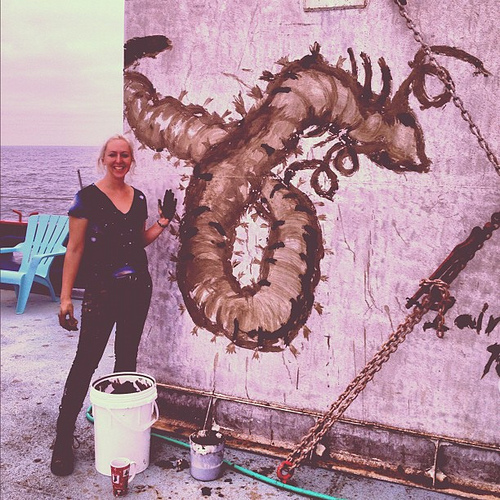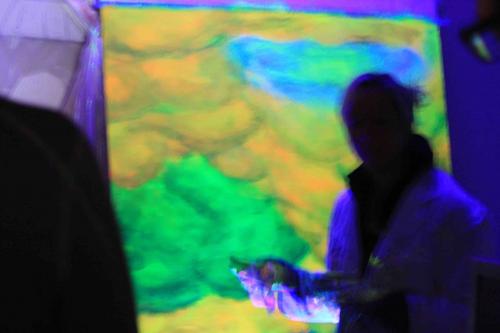Art on the Ice
Every Sunday at McMurdo Base, there is a "Science Lecture" after dinner. I have attended a couple of these lectures, and they have always been pretty interesting. There was one about Meteorites in Antarctica, another about Marine Ecosystems in the McMurdo Sound, and another about Life in the Dry Valleys.
This week, however, the title of the talk caught my attention, because it seemed different from the ones before it – Art Under the Sea Ice.
The talk was by Lily Simonson, an artist based out of Los Angeles California, who is here as part of the National Science Foundation's Artists and Writers Program.

This program is designed to provide opportunities for scholars and professionals in the humanities to explore the Antarctic continent, produce serious works of writing and art, and help increase understanding about Antarctic science and heritage. Previous participants have included a wide variety of visual and graphic artists, photographers, historians, science writers, poets, musicians, and writers.
More about the program can be learned here: http://www.nsf.gov/geo/plr/aawr.jsp
With a full hour for the talk, we were able to hear in a fair amount of detail all about Lily's journey as an artist, and the sequence of events that brought her to Antarctica, in addition to hearing about and seeing images of her work.
Lily's story began with a childhood obsession: Lobsters.

The Lobster Years
Apparently as a young girl, Lily grew up in Maryland, where there were fresh lobsters in tanks at every supermarket. She would stand around staring at them and doodle them all the time.
The way she described it, this personal fascination of hers is actually a common artistic subject. She showed us a variety of famous artists who had used lobsters in their work.
Although both her parents were artists, she did not expect to go into that field. As a freshman at UC Berkeley, she took a painting class and decided she loved it.
Her first major series of work was a collection of humongous lobster paintings.

Having explored this subject thoroughly, she says that she moved onto something that also held a special place in her childhood.
The Moth Years
Unlike her fascination of lobsters, moths were a childhood phobia of Lily's. She decided to explore this fear through her work, and began painting moths.
She would catch moths, and use them as specimens for her paintings. She described how she went from first just drawing and painting their bodies and colors to eventually wanting to capture the finer details, like their "hairy quality" and the way they moved.
She displayed images from a few of her paintings in this series, and, sure enough, they looked just like sitting in a room at night and watch a moth flutter its way up to a singular source of light.

There was something extremely lifelike and realistic about the way she portrayed these organisms. Her attention to detail, thorough observation, and precise recapturing of them was almost scientific in nature. Yet, she would imagine story lines and add her own details to the backgrounds, like disco lights at a dance party, setting free her own creative engagement with the subject as well.
The Yeti Crab
Before long, Lily was known for her work with lobsters and moths. Then, one day, as she describes it, she was introduced to her soulmate.
The Yeti Crab is a blind sea crab with hairy pincers that are thought to detoxify harmful minerals out of chemical vents in the ocean where it lives and feed off of the bacteria that reside there (a process known as chemosynthesis). It was discovered off the coast of Easter Island, along the Pacific-Antarctic ridge, in 2005.
It was a new species discovery, and quite a big deal. Lily was instantly fascinated, and began a communication with the scientists studying it in a lab in France. Before long, she was flying to Paris to "meet" the Yeti crab.
She wanted to hold it and interact with it directly, so she could eventually paint it. Using sketches and photographs from her time in Paris, she moved onto a new series of paintings on the Yeti crab.

Science meets Art
By this point, I was starting to see a pattern. Lily seems to be a one-pointed, almost compulsively obsessed artist that chooses a subject and needs to see, touch, sense and then recreate everything about it.
This process is similar to a scientist's when studying an organism – thorough observation, attention to detail, the desire for complete understanding, and a fascination with the subject that grows as more is learned about it.
In fact, reviews of Lily's work call her part-artist, part-scientist, and she has been invited to speak and present her artwork at various scientific conferences. In exploring the animals she paints, she learns all about their biology, chemistry, anatomy, ecosystems and habitat, feeding habits, life and mating cycles.
She began working with the Scripps Institute of Oceanography, borrowing marine animals, samples and specimens from their laboratory to paint. She joined a science team on a marine expedition, and created artwork of a variety of new marine species they were finding and researching.

When presenting at a science conference, she reconnected an old high school classmate, who happened to be the lead investigator on an Antarctic research team studying the Dry Valleys. He invited her to join his team as an embedded artist, and she took her first trip to the ice.
While there, she painted a particular "buried" glacier at Garwood Valley, which has been important for understanding the climate record of the last ice age, due to its highly stratified layers of ice and sediments.

Art Under the Ice
And now, this season, she has blended her love of marine life and her experience in Antarctica. As part of the Artist and Writers Program, she has been scuba diving and painting the marine environment underneath the Sea Ice. Using a black light, she also captures the iridescent quality of the under-ice ecosystem.

All of the work she does this season will be displayed in an exhibit back home once she returns to LA.
Lily Simonson's artwork seems to occupy a very interesting and important niche in both the artistic and scientific communities. She seems to be glad to play the role of a liaison between the two. As she put it during her talk, "it's nice to have scientists paying attention to art, and artists paying attention to science for a change."


Comments